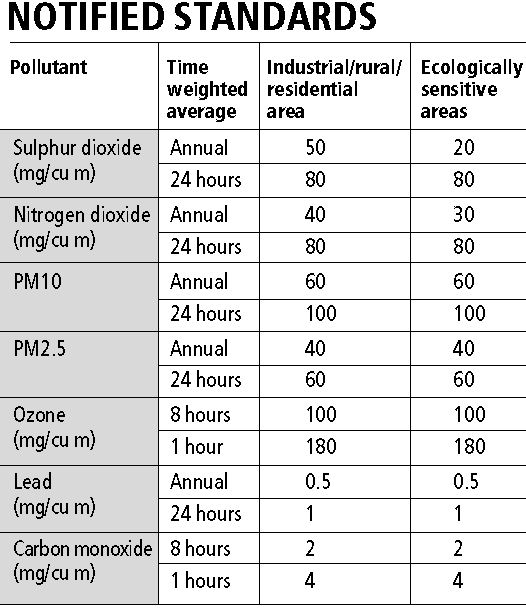- India
- International
Lab in a box
In Delhi, the city with worst air quality in the world, monitoring the level of pollutants is a continuous exercise for seven CPCB stations.
 A metal container, innocuously placed behind a busy bus stop outside the Pragati Maidan metro station, is feeling the heat these days. The 6X2 metre box — the kind you are more likely to see on trucks or in ships — houses a makeshift laboratory displaced from its original location at a nearby building in ITO because of the ongoing construction of an underground metro station. This laboratory, one of seven in Delhi run by the Central Pollution Control Board (CPCB), has been monitoring air quality and measuring the presence of pollutants and harmful chemicals in the air round the clock. There has been a sudden buzz around air pollution in the last few months, and Delhi’s air quality, dubbed by many as the worst in the world, has been under severe scrutiny.
A metal container, innocuously placed behind a busy bus stop outside the Pragati Maidan metro station, is feeling the heat these days. The 6X2 metre box — the kind you are more likely to see on trucks or in ships — houses a makeshift laboratory displaced from its original location at a nearby building in ITO because of the ongoing construction of an underground metro station. This laboratory, one of seven in Delhi run by the Central Pollution Control Board (CPCB), has been monitoring air quality and measuring the presence of pollutants and harmful chemicals in the air round the clock. There has been a sudden buzz around air pollution in the last few months, and Delhi’s air quality, dubbed by many as the worst in the world, has been under severe scrutiny.
It falls on CPCB laboratories such as these, and some others of the Delhi Pollution Control Committee (DPCC), to measure the health of Delhi’s air. Many of these laboratories, like the one temporarily operating from outside Pragati Maidan metro station, have been functioning for several years. But it is only now that their data is being keenly followed.
The main villainous substances in the air, which these laboratories watch out for, are the oxides of nitrogen (NO and NO2), the oxides of sulphur (mainly sulphur oxide or SO2), and micron-level particulate matters, or PM. Micron, or a micrometer, is one millionth of a metre. Particles up to a size of 2.5 microns, or PM2.5, can be inhaled like other gases. Those up to the size of 10 microns, or PM10, are usually too big to be inhaled, but are still a health hazard as they enter the body through the mouth or by settling down in food. In addition, the presence of lead, nickel, arsenic, and ammonia are also monitored. These chemicals and particles lead to a variety of respiratory problems.
 Monitoring the level of pollutants in the air is a continuous exercise, a 24X7 operation in some of these laboratories, like the one at Pragati Maidan. This station uses both manual as well as automated procedures to carry out the measurements. The automated process involves an imported instrument called ‘automatic air analyser’, a long, rod-like receiver which is placed on the roof of the laboratory. The receiver sucks in air from the atmosphere and sends it into the analyser kept inside the laboratory. The levels of different pollutants are constantly displayed on the monitor of the instrument and this data is relayed to the central control room at the CPCB every two minutes. The analyser is able to detect the level of pollutants in real time and it is this near-instantaneous measurement that is put out for the public.
Monitoring the level of pollutants in the air is a continuous exercise, a 24X7 operation in some of these laboratories, like the one at Pragati Maidan. This station uses both manual as well as automated procedures to carry out the measurements. The automated process involves an imported instrument called ‘automatic air analyser’, a long, rod-like receiver which is placed on the roof of the laboratory. The receiver sucks in air from the atmosphere and sends it into the analyser kept inside the laboratory. The levels of different pollutants are constantly displayed on the monitor of the instrument and this data is relayed to the central control room at the CPCB every two minutes. The analyser is able to detect the level of pollutants in real time and it is this near-instantaneous measurement that is put out for the public.
The manual procedure, on the other hand, is more tedious and involves almost a day’s time lag. The levels of NO2 and SO2 are checked every four hours, while the particulate matter concentration is assessed every eight hours. These readings are then averaged over a day and then recorded on a data sheet. The laboratories send this data only once a month unless they are specifically asked for it in between.

However, the manual exercise is a better indicator of the long-term levels of air pollution. “Worldwide, manually measured data is the most acceptable for assessing air quality over long periods. So if we have to know how Delhi’s air quality has been over a year, the manual exercise is more helpful,” said Dipankar Saha, head of Air Lab at CPCB.
The manual exercise involves an indigenously built ‘Respiratory Dust Sampler’ that is used to collect air samples for carrying out chemical tests. Three test tubes are placed inside this instrument, one each to assess the quantities of SO2, NO2 and ozone. A white filter paper is used for determining the quantity of particulate matters.
The laboratory at Pragati Maidan works in three shifts, with one person manning each shift. The readings taken through the day and night are checked and compiled by the person on duty in the morning shift.
Pragati Maidan metro station returns high concentration levels of these pollutants through most of day, but the highest readings come after midnight when trucks and heavy vehicles start plying. The gases and particulate matters released by these vehicles remain in the air for a while and it is not before 8 or 9 am that the readings start going down a bit. But then, peak hour traffic starts again and the readings move up.
“At Pragati Maidan, we are located right on the road, measuring the pollutants almost at the source of their release. However, what is important is assessing ambient air quality. That means measuring the concentration of pollutants in air away from the source of pollution. The Pragati Maidan station will soon be back at its original location, and then its readings will be a much better reflection of the quality of air in the surroundings,” Saha said.
Apr 23: Latest News
- 01
- 02
- 03
- 04
- 05






































